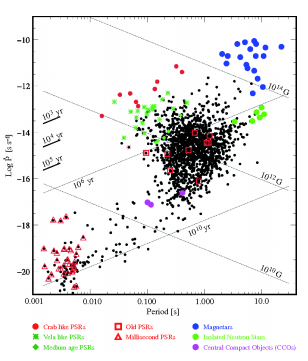An Interplanetary GPS Using Pulsar Signals
Navigating in space is a tricky business. The usual method relies on Earth-based tracking stations to work out a spacecraft’s distance using radio waves, a process that is accurate to within a metre or so.

That’s fine for the radial distance, but tracking a spacecraft’s angular position is much harder because of the limited angular resolution of radio antennas. The current technology produces an uncertainty of about four kilometres per astronomical unit of distance between Earth and the spacecraft.
So for a spacecraft at the distance of Pluto, that’s an uncertainty of 200 kilometres and at the distance of Voyager 1, the uncertainty is 500 kilometres.
So a way for spacecraft to determine their own position accurately would clearly be useful.
Today, Werner Becker at the Max-Planck Institute for extraterrestrial Physics in Germany and a couple of pals have worked out the practical details for an autonomous spacecraft navigation system using pulsars signals. They say that technology being developed now would allow spacecraft to work out their position to within five kilometres anywhere in the solar system.
The idea of using pulsars to navigate in space dates back several decades. But Becker and co say previous analyses have been hampered by a limited knowledge of pulsars and the relatively bulky technology that has been available to detect them. Both of those things have changed dramatically in recent years.
First, the number of known pulses is growing significantly. Astronomers are aware of well over 2,000 pulsars and the next generation of radio observatories are expected to reveal tens of thousands more.
The basic idea behind this interplanetary navigation system is to use the signals from these pulsars in essentially the same way that we use GPS satellites to navigate on Earth. By measuring the arrival time of pulses from at least three different pulsars and comparing this with their predicted arrival time, it is possible to work out a position in three-dimensional space.
(Since pulsars produce a stream of identical pulses, it is possible to generate any number of ambiguous solutions when doing this. But Becker and co point out that these can be eliminated by constraining the solutions to a finite volume around the assumed position.)
The feasibility of such a system depends on a number of important practical factors, largely determined by the wavelength of the pulsar radiation that the navigation system is designed to detect. This determines the antenna collecting area, the power consumption, the weight of the navigation system, and of course its cost.
Becker and co calculate that for 21-centimeter waves, the spacecraft would require an antenna with a collecting area of 150 square meters.
But a better idea, they say, is to use pulsars that emit x-rays since the technology for collecting and focusing x-rays has improved dramatically in recent years.
One measure of the performance of x-ray mirrors is their mass. The mirror used on the Chandra X-ray Observatory launched in 1999 had a mass of 18.5 tonnes per square metre of effective collecting area. By comparison, the state-of-the-art glass micropore optics being made today have a mass of only 25 kilograms for the same collecting area.
So x-ray optics make good sense for pulsar navigation, say Becker and co. “Using the X-ray signals from millisecond pulsars we estimated that navigation would be possible with an accuracy of ±5 km in the solar system and beyond,” they say.
It may not be necessary to have this accuracy for most missions envisaged in the short term. However Becker and pals are optimistic about its future potential: “It is clear already today that this navigation technique will find its applications in future astronautics.” As they say, to infinity and beyond …
Ref: arxiv.org/abs/1305.4842: Autonomous Spacecraft Navigation With Pulsars
Keep Reading
Most Popular
Large language models can do jaw-dropping things. But nobody knows exactly why.
And that's a problem. Figuring it out is one of the biggest scientific puzzles of our time and a crucial step towards controlling more powerful future models.
The problem with plug-in hybrids? Their drivers.
Plug-in hybrids are often sold as a transition to EVs, but new data from Europe shows we’re still underestimating the emissions they produce.
Google DeepMind’s new generative model makes Super Mario–like games from scratch
Genie learns how to control games by watching hours and hours of video. It could help train next-gen robots too.
How scientists traced a mysterious covid case back to six toilets
When wastewater surveillance turns into a hunt for a single infected individual, the ethics get tricky.
Stay connected
Get the latest updates from
MIT Technology Review
Discover special offers, top stories, upcoming events, and more.